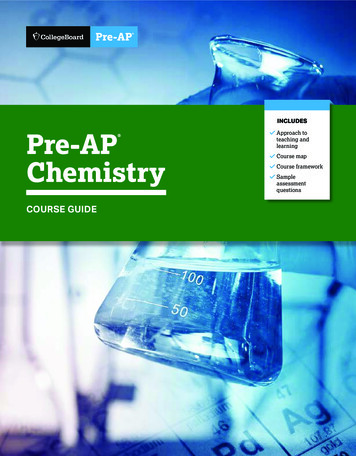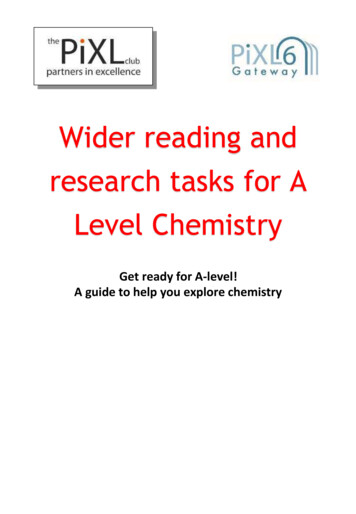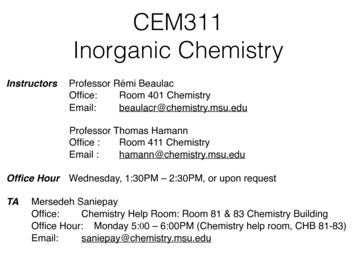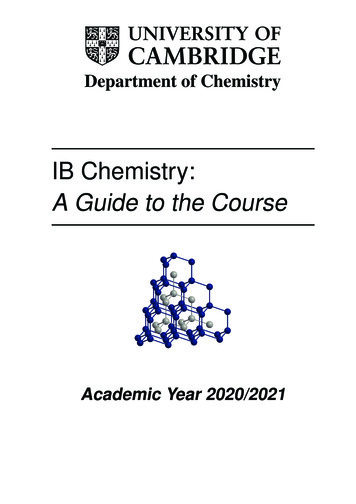
Transcription
INCLUDESPre-APChemistry COURSE GUIDEApproach toteaching andlearningCourse mapCourse frameworkSampleassessmentquestions
Pre-APChemistry COURSE GUIDEPlease visit Pre-AP online at preap.collegeboard.org for more information and updates aboutthe course and program features.
ABOUT COLLEGE BOARDCollege Board is a mission-driven not-for-profit organization that connects students to collegesuccess and opportunity. Founded in 1900, College Board was created to expand accessto higher education. Today, the membership association is made up of over 6,000 of theworld’s leading educational institutions and is dedicated to promoting excellence and equityin education. Each year, College Board helps more than seven million students prepare fora successful transition to college through programs and services in college readiness andcollege success—including the SAT and the Advanced Placement Program . The organizationalso serves the education community through research and advocacy on behalf of students,educators, and schools.For further information, visit www.collegeboard.org.PRE-AP EQUITY AND ACCESS POLICYCollege Board believes that all students deserve engaging, relevant, and challenging gradelevel coursework. Access to this type of coursework increases opportunities for all students,including groups that have been traditionally underrepresented in AP and college classrooms.Therefore, the Pre-AP program is dedicated to collaborating with educators across the countryto ensure all students have the supports to succeed in appropriately challenging classroomexperiences that allow students to learn and grow. It is only through a sustained commitment toequitable preparation, access, and support that true excellence can be achieved for all students,and the Pre-AP course designation requires this commitment.ISBN: 978-1-4573-1486-5 2021 College Board. PSAT/NMSQT is a registered trademark of the College Board and National MeritScholarship Corporation.1 2 3 4 5 6 7 8 9 10
ContentsvAcknowledgmentsABOUT PRE-AP33Introduction to Pre-APDeveloping the Pre-AP Courses4How to Get Involved3Pre-AP Educator Network55Pre-AP Approach to Teaching and LearningFocused Content8Targeted Assessments for Learning59Horizontally and Vertically Aligned InstructionPre-AP Professional LearningABOUT PRE-AP CHEMISTRY1313Introduction to Pre-AP ChemistryPre-AP Science Areas of Focus16Summary of Resources and Supports1518Pre-AP Chemistry and Career ReadinessCourse Map2020Pre-AP Chemistry Course FrameworkIntroduction22Big Ideas in Pre-AP Chemistry212324283336Course Framework ComponentsOverview of Pre-AP Chemistry Units and Enduring UnderstandingsUnit 1: Structure and Properties of MatterUnit 2: Chemical Bonding and InteractionsUnit 3: Chemical QuantitiesUnit 4: Chemical Transformations4243Pre-AP Chemistry Model LessonsSupport Features in Model Lessons4444Pre-AP Chemistry Assessments for LearningLearning Checkpoints48Sample Performance Task and Scoring Guidelines4663646971Performance TasksFinal ExamSample Assessment QuestionsPre-AP Chemistry Course DesignationAccessing the Digital Materials
7577APPENDIXPre-AP Chemistry Equations, Constants, and Tables of InformationPeriodic Table of the Elements
AcknowledgmentsCollege Board would like to acknowledge the following committee members, consultants, andreviewers for their assistance with and commitment to the development of this course. Allindividuals and their affiliations were current at the time of their contribution.Roxie Allen, St. John’s School, Houston, TXKristen Cacciatore, Charlestown High School, Boston, MAMichael Diaz, Achievement First, New Haven, CTKristen Drury, William Floyd High School, Mastic Beach, NYAmy Earle, Deep Run High School, Richmond, VARyan Johnson, Doherty High School, Colorado Springs, CODena Leggett, Franklin High School, Franklin, TNPaul Price, Trinity Valley School, Fort Worth, TXKaleb Underwood, Education Consultant, Charlottesville, VAFred Vital, Darien High School, Darien, CTDavid Yaron, Carnegie Mellon University, Pittsburgh, PACOLLEGE BOARD STAFFLaura Casdorph, Director, Pre-AP Chemistry Curriculum, Instruction, and AssessmentKaren Lionberger, Senior Director, Pre-AP STEM Curriculum, Instruction, and AssessmentBeth Hart, Senior Director, Pre-AP AssessmentMitch Price, Director, Pre-AP STEM AssessmentNatasha Vasavada, Executive Director, Pre-AP Curriculum, Instruction, and Assessment
About Pre-AP
About Pre-APIntroduction to Pre-APEvery student deserves classroom opportunities to learn, grow, and succeed. CollegeBoard developed Pre-AP to deliver on this simple premise. Pre-AP courses aredesigned to support all students across varying levels of readiness. They are not honorsor advanced courses.Participation in Pre-AP courses allows students to slow down and focus on the mostessential and relevant concepts and skills. Students have frequent opportunitiesto engage deeply with texts, sources, and data as well as compelling higher-orderquestions and problems. Across Pre-AP courses, students experience sharedinstructional practices and routines that help them develop and strengthen theimportant critical thinking skills they will need to employ in high school, college, andlife. Students and teachers can see progress and opportunities for growth throughvaried classroom assessments that provide clear and meaningful feedback at keycheckpoints throughout each course.DEVELOPING THE PRE-AP COURSESPre-AP courses are carefully developed in partnership with experienced educators,including middle school, high school, and college faculty. Pre-AP educator committeeswork closely with College Board to ensure that the course resources define, illustrate,and measure grade-level-appropriate learning in a clear, accessible, and engaging way.College Board also gathers feedback from a variety of stakeholders, including Pre-APpartner schools from across the nation who have participated in multiyear pilots ofselect courses. Data and feedback from partner schools, educator committees, andadvisory panels are carefully considered to ensure that Pre-AP courses provide allstudents with grade-level-appropriate learning experiences that place them on a path tocollege and career readiness.PRE-AP EDUCATOR NETWORKSimilar to the way in which teachers of Advanced Placement (AP ) courses canbecome more deeply involved in the program by becoming AP Readers or workshopconsultants, Pre-AP teachers also have opportunities to become active in theireducator network. Each year, College Board expands and strengthens the Pre-APNational Faculty—the team of educators who facilitate Pre-AP Readiness Workshopsand Pre-AP Summer Institutes. Pre-AP teachers can also become curriculum andassessment contributors by working with College Board to design, review, or pilot thecourse resources.3
About Pre-APIntroduction to Pre-APHOW TO GET INVOLVEDSchools and districts interested in learning more about participating in Pre-AP shouldvisit preap.collegeboard.org/join or contact us at preap@collegeboard.org.Teachers interested in becoming members of Pre-AP National Faculty or participatingin content development should visit preap.collegeboard.org/national-faculty orcontact us at preap@collegeboard.org.Pre-AP Chemistry4Course Guide 2021 College Board
About Pre-APPre-AP Approach to Teaching and LearningPre-AP courses invite all students to learn, grow, and succeed through focused content,horizontally and vertically aligned instruction, and targeted assessments for learning.The Pre-AP approach to teaching and learning, as described below, is not overlycomplex, yet the combined strength results in powerful and lasting benefits for bothteachers and students. This is our theory of action.Horizontally andVertically AlignedInstructionShared Principles,Areas of FocusFocused ContentCourse Frameworks,Model LessonsTargeted Assessmentsand FeedbackLearning Checkpoints,Performance Tasks,Final ExamFOCUSED CONTENTPre-AP courses focus deeply on a limited number of concepts and skills with thebroadest relevance for high school coursework and college and career success. Thecourse framework serves as the foundation of the course and defines these prioritizedconcepts and skills. Pre-AP model lessons and assessments are based directly on thisfocused framework. The course design provides students and teachers with intentionalpermission to slow down and focus.HORIZONTALLY AND VERTICALLY ALIGNED INSTRUCTIONShared principles cut across all Pre-AP courses and disciplines. Each course is alsoaligned to discipline-specific areas of focus that prioritize the critical reasoning skillsand practices central to that discipline.5
About Pre-APPre-AP Approach to Teaching and LearningSHARED PRINCIPLESAll Pre-AP courses share the following set of research-supported instructionalprinciples. Classrooms that regularly focus on these cross-disciplinary principles allowstudents to effectively extend their content knowledge while strengthening their criticalthinking skills. When students are enrolled in multiple Pre-AP courses, the horizontalalignment of the shared principles provides students and teachers across disciplineswith a shared language for their learning and investigation, and multiple opportunitiesto practice and grow. The critical reasoning and problem-solving tools studentsdevelop through these shared principles are highly valued in college coursework and inthe workplace.Close Observationand ngSHAREDPRINCIPLESAcademicConversationClose Observation and AnalysisStudents are provided time to carefully observe one data set, text, image, performancepiece, or problem before being asked to explain, analyze, or evaluate. This createsa safe entry point to simply express what they notice and what they wonder. It alsoencourages students to slow down and capture relevant details with intentionality tosupport more meaningful analysis, rather than rushing to completion at the expenseof understanding.Higher-Order QuestioningStudents engage with questions designed to encourage thinking that is elevatedbeyond simple memorization and recall. Higher-order questions require students tomake predictions, synthesize, evaluate, and compare. As students grapple with thesequestions, they learn that being inquisitive promotes extended thinking and leads todeeper understanding.Pre-AP Chemistry6Course Guide 2021 College Board
About Pre-APPre-AP Approach to Teaching and LearningEvidence-Based WritingWith strategic support, students frequently engage in writing coherent argumentsfrom relevant and valid sources of evidence. Pre-AP courses embrace a purposefuland scaffolded approach to writing that begins with a focus on precise and effectivesentences before progressing to longer forms of writing.Academic ConversationThrough peer-to-peer dialogue, students’ ideas are explored, challenged, and refined.As students engage in academic conversation, they come to see the value in beingopen to new ideas and modifying their own ideas based on new information. Studentsgrow as they frequently practice this type of respectful dialogue and critique and learnto recognize that all voices, including their own, deserve to be heard.AREAS OF FOCUSSocial StudiesScienceMathematicsEnglishArtsThe areas of focus are discipline-specific reasoning skills that students developand leverage as they engage with content. Whereas the shared principles promotehorizontal alignment across disciplines, the areas of focus provide vertical alignmentwithin a discipline, giving students the opportunity to strengthen and deepen theirwork with these skills in subsequent courses in the same discipline.Areas of FocusAlign Vertically Within Disciplines(Grades 6-12)Academic ConversationHigher-Order QuestioningEvidence-Based WritingClose Observation and AnalysisShared PrinciplesAlign Horizontally Across All CoursesFor information about the Pre-AP science areas of focus, see page 13.7
About Pre-APPre-AP Approach to Teaching and LearningTARGETED ASSESSMENTS FOR LEARNINGPre-AP courses include strategically designed classroom assessments that serve astools for understanding progress and identifying areas that need more support. Theassessments provide frequent and meaningful feedback for both teachers and studentsacross each unit of the course and for the course as a whole. For more informationabout assessments in Pre-AP Chemistry, see page 44.Pre-AP Chemistry8Course Guide 2021 College Board
About Pre-APPre-AP Professional LearningThe summer before their first year teaching a Pre-AP course, teachers are requiredto engage in professional learning offered by College Board. There are two optionsto meet this requirement: the Pre-AP Summer Institute (Pre-APSI) and the OnlineFoundational Module Series. Both options provide continuing education units toeducators who complete the training. The Pre-AP Summer Institute is a four-day collaborative experience that empowersparticipants to prepare and plan for their Pre-AP course. While attending, teachersengage with Pre-AP course frameworks, shared principles, areas of focus, andsample model lessons. Participants are given supportive planning time where theywork with peers to begin to build their Pre-AP course plan. The Online Foundational Module Series will be available beginning July 2020 toall teachers of Pre-AP courses. These 12- to 20-hour courses will support teachersin preparing for their Pre-AP course. Teachers will explore course materials andexperience model lessons from the student’s point of view. They will also beginto plan and build their own course materials, so they are ready on day one ofinstruction.Pre-AP teachers also have access to the Online Performance Task Scoring Modules,which offer guidance and practice applying Pre-AP scoring guidelines to student work.9
About Pre-APChemistry
About Pre-AP ChemistryIntroduction to Pre-AP ChemistryThe Pre-AP Chemistry course emphasizes the integration of content with sciencepractices—powerful reasoning tools that support students in analyzing the naturalworld around them. Having this ability is one of the hallmarks of scientific literacy andis critical for numerous college and career endeavors in science and the social sciences.Rather than seeking to cover all topics traditionally included in a standard chemistrytextbook, this course focuses on the foundational chemistry knowledge and skillsthat matter most for college and career readiness. The Pre-AP Chemistry CourseFramework highlights how to guide students to connect core ideas within and acrossthe units of the course, promoting the development of a coherent understanding ofmatter at the atomic scale.The components of this course have been crafted to prepare not only the nextgeneration of chemists, but also a broader base of chemistry-informed citizens who arewell equipped to respond to the array of science-related issues that impact our lives atthe personal, local, and global levels.PRE-AP SCIENCE AREAS OF FOCUSThe Pre-AP science areas of focus, shown below, are science practices that studentsdevelop and leverage as they engage with content. They were identified througheducator feedback and research about where students and teachers need the mostcurriculum support. These areas of focus are vertically aligned to the science practicesembedded in other science courses in high school, including AP, and in college, givingstudents multiple opportunities to strengthen and deepen their work with these skillsthroughout their educational career. They also support and align to the NGSS and APscience practices of theory building and refinement.Strategic Use ofMathematicsEmphasison AnalyticalReading andScienceWritingAreas of Focus13AttentiontoModeling
About Pre-AP ChemistryIntroduction to Pre-AP ChemistryEmphasis on Analytical Reading and WritingStudents engage in analytical reading and writing to gain, retain, and applyscientific knowledge and to carry out scientific argumentation.In prioritizing analytical reading, Pre-AP Chemistry classrooms ask students toextract, synthesize, and compare complex information, often by moving betweentexts, tables and graphs of experimental data, and representations of motions andinteractions at the molecular level. Through analytical writing activities, Pre-APChemistry students must integrate and translate that information to generate scientificquestions, design methods for answering questions, and develop scientific arguments.Moreover, the application of these skills to the understanding of informal sciencetexts, such as articles found in newspapers, online sources, and magazines, preparesstudents to be discerning consumers of scientific information.Strategic Use of MathematicsStudents integrate mathematics with conceptual understanding to model chemicalphenomena.Mathematics is an essential tool for the study of chemistry. However, introductorychemistry courses often focus on the use of mathematics without context-focusedapplications. This practice can result in students being able to solve mathematicalproblems in chemistry class, but without an understanding of the underlying chemicalprinciples. As an alternative approach, Pre-AP Chemistry requires students todemonstrate their knowledge using multiple representations that integrate conceptualunderstanding with the use of mathematics. Students are also challenged to usedata and observations to build mathematical models that reflect their conceptualunderstanding and can be used to make predictions.Attention to ModelingStudents develop and refine models to connect macroscopic observations tostructure, motion, and interactions occurring at the atomic scale.In Pre-AP Chemistry, the development of models to explain their macroscopicobservations is a primary means through which students develop an understandingof the molecular world. Engaging students in creating and revising models reinforcesother scientific reasoning skills, such as data analysis and scientific argumentation.Modeling also helps illustrate for students how scientific knowledge is constructed andmodified over time as new data and evidence emerge and models are revised based onthis new information.Pre-AP Chemistry14Course Guide 2021 College Board
About Pre-AP ChemistryIntroduction to Pre-AP ChemistryPRE-AP CHEMISTRY AND CAREER READINESSThe Pre-AP Chemistry course resources are designed to expose students to a wide range ofcareer opportunities that depend upon chemistry knowledge and skills. Chemistry lies atthe interface of the physical and life sciences. As science, engineering, and healthcare moveincreasingly towards the molecular scale, chemistry provides ideal preparation for 21stcentury careers. Examples include not only careers within the physical sciences, such asforensic scientist or food chemist, but also other endeavors where chemistry knowledge isrelevant such as the work of an engineer, policymaker, or healthcare worker.Career clusters that involve chemistry, along with examples of careers in chemistry orrelated to chemistry, are provided below. Teachers should consider discussing thesewith students throughout the year to promote motivation and engagement.Career Clusters Involving Chemistryagriculture, food, and natural resourceshealthcare and health sciencehospitality and tourisminformation technologymanufacturingSTEM (science, technology, engineering,and math)Examples of Chemistry CareersExamples of Chemistry Related Careersatmospheric chemistchemical engineerchemistry teacher/professorenvironmental chemistfood chemistgeochemisthazardous waste managermaterials scientistmedicinal chemistnanotechnologistsynthetic chemistenvironmental scientistforensic scientistmedical assistantpatent lawyerpharmacistpharmacologistphysicianphysician assistantscience writertechnical salestoxicologistSource for Career Clusters: “Advanced Placement and Career and Technical Education: Working Together.”Advance CTE and the College Board. October 2018. ther.For more information about careers that involve chemistry, teachers and students canvisit and explore the College Board’s Big Future s/physical-sciences-chemistry-chemistry.15
About Pre-AP ChemistryIntroduction to Pre-AP ChemistrySUMMARY OF RESOURCES AND SUPPORTSTeachers are strongly encouraged to take advantage of the full set of resources andsupports for Pre-AP Chemistry, which is summarized below. Some of these resourcesmust be used for a course to receive the Pre-AP Course Designation. To learn moreabout the requirements for course designation, see details below and on page 69.COURSE FRAMEWORKIncluded in this guide as well as in the Pre-AP Chemistry Teacher Resources, theframework defines what students should know and be able to do by the end of thecourse. It serves as an anchor for model lessons and assessments, and it is the primarydocument teachers can use to align instruction to course content. Use of the courseframework is required. For more details see page 20.MODEL LESSONSTeacher resources, available in print and online, include a robust set of model lessonsthat demonstrate how to translate the course framework, shared principles, and areas offocus into daily instruction. Use of the model lessons is encouraged but not required.For more details see page 42.LEARNING CHECKPOINTSAccessed through Pre-AP Classroom (the Pre-AP digital platform), these shortformative assessments provide insight into student progress. They are automaticallyscored and include multiple-choice and technology-enhanced items with rationalesthat explain correct and incorrect answers. Use of one learning checkpoint per unit isrequired. For more details see page 44.PERFORMANCE TASKSAvailable in the printed teacher resources as well as on Pre-AP Classroom,performance tasks allow students to demonstrate their learning through extendedproblem-solving, writing, analysis, and/or reasoning tasks. Scoring guidelines areprovided to inform teacher scoring, with additional practice and feedback suggestionsavailable in online modules on Pre-AP Classroom. Use of each unit’s performancetask is required. For more details see page 46.PRACTICE PERFORMANCE TASKSAvailable in the student resources, with supporting materials in the teacher resources, thesetasks provide an opportunity for students to practice applying skills and knowledge as theywould in a performance task, but in a more scaffolded environment. Use of the practiceperformance tasks is encouraged but not required. For more details see page 47.Pre-AP Chemistry16Course Guide 2021 College Board
About Pre-AP ChemistryIntroduction to Pre-AP ChemistryFINAL EXAMAccessed through Pre-AP Classroom, the final exam serves as a classroom-based,summative assessment designed to measure students’ success in learning and applyingthe knowledge and skills articulated in the course framework. Administration of thefinal exam is encouraged but not required. For more details see page 63.PROFESSIONAL LEARNINGBoth the four-day Pre-AP Summer Institute (Pre-APSI) and the Online FoundationalModule Series support teachers in preparing and planning to teach their Pre-APcourse. All Pre-AP teachers are required to either attend the Pre-AP SummerInstitute or complete the module series. In addition, teachers are required tocomplete at least one Online Performance Task Scoring module. For more details seepage 9.17
UNIT 1Course MapStructure andProperties ofMatter 30 Class PeriodsPre-AP model lessons provided forapproximately 50% of instructionaltime in this unitPLANThe course map shows how components are positioned throughoutthe course. As the map indicates, the course is designed to be taughtover 140 class periods (based on 45-minute class periods), for a totalof 28 weeks.Model lessons are included for approximately 50% of the totalinstructional time, with the percentage varying by unit. Each unit isdivided into key concepts.KEY CONCEPT 1.1Particle View of States of MatterLearning Checkpoint 1KEY CONCEPT 1.2TEACHPhase Changes and ParticleInteractionsShared PrinciplesClose observation and analysisHigher-order questioningEvidence-based writingAcademic conversationKEY CONCEPT 1.3The model lessons demonstrate how the Pre-AP shared principlesand science areas of focus come to life in the classroom.Kinetic Molecular TheoryLearning Checkpoint 2Areas of FocusEmphasis on analytical reading and writingStrategic use of mathematicsAttention to modelingPerformance Task for Unit 1ASSESS AND REFLECTEach unit includes two learning checkpoints and a performance task.These formative assessments are designed to provide meaningfulfeedback for both teachers and students.Note: The final exam, available beginning in the 2021–22 school year,is not represented in the map.Pre-AP Chemistry18Course Guide 2021 College Board
UNIT 2ChemicalBonding andInteractions 40 Class PeriodsPre-AP model lessons provided forapproximately 40% of instructionaltime in this unitKEY CONCEPT 2.1UNIT 3ChemicalQuantities 30 Class PeriodsPre-AP model lessons provided forapproximately 30% of instructionaltime in this unitUNIT 4ChemicalTransformations 40 Class PeriodsPre-AP model lessons provided forapproximately 30% of instructionaltime in this unitClassification and Interactions ofMatterKEY CONCEPT 3.1KEY CONCEPT 4.1Counting Particles in SubstancesPrecipitation ChemistryKEY CONCEPT 2.2Learning Checkpoint 1KEY CONCEPT 4.2Learning Objectives 2.2.A.1–2.2.C.1Molecular Structure and PropertiesKEY CONCEPT 3.2Oxidation–Reduction ChemistryLearning Checkpoint 1Counting Particles in ChemicalReactionsLearning Checkpoint 1KEY CONCEPT 2.2 (continued)Learning Checkpoint 2KEY CONCEPT 4.3Learning Objectives 2.2.D.1–2.2.G.1Molecular Structure and PropertiesPerformance Task for Unit 3Acid–Base ChemistryKEY CONCEPT 2.3KEY CONCEPT 4.4Covalent and Ionic BondingThermochemistryLearning Checkpoint 2KEY CONCEPT 4.5Reaction RatesPerformance Task for Unit 2Learning Checkpoint 2Performance Task for Unit 4Course Guide 2021 College Board19Pre-AP Chemistry
About Pre-AP ChemistryPre-AP Chemistry Course FrameworkINTRODUCTIONBased on the Understanding by Design (Wiggins and McTighe) model, the Pre-APChemistry Course Framework is back mapped from AP expectations and aligned toessential grade-level expectations. The course framework serves as a teacher’s blueprintfor the Pre-AP Chemistry instructional resources and assessments.The course framework was designed to meet the following criteria: Focused: The framework provides a deep focus on a limited number of conceptsand skills that have the broadest relevance for later high school, college, and careersuccess. Measurable: The framework’s learning objectives are observable and measurablestatements about the knowledge and skills students should develop in the course. Manageable: The framework is manageable for a full year of instruction, fostersthe ability to explore concepts in depth, and enables room for additional local orstate standards to be addressed where appropriate. Accessible: The framework’s learning objectives are designed to provide allstudents, across varying levels of readiness, with opportunities to learn, grow, andsucceed.Pre-AP Chemistry20Course Guide 2021 College Board
About Pre-AP ChemistryPre-AP Chemistry Course FrameworkCOURSE FRAMEWORK COMPONENTSThe Pre-AP Chemistry Course Framework includes the following components:Big IdeasThe big ideas are recurring themes that allow students to create meaningfulconnections between course concepts. Revisiting the big ideas throughout thecourse and applying them in a variety of contexts allows students to develop deeperconceptual understandings.Enduring UnderstandingsEach unit focuses on a small set of enduring understandings. These are the long-termtakeaways related to the big ideas that leave a lasting impression on students. Studentsbuild and earn these understandings over time by exploring and applying coursecontent throughout the year.Key ConceptsTo support teacher planning and instruction, each unit is organized by key concepts.Each key concept includes relevant learning objectives and essential knowledgestatements and may also include content boundary and cross connection statements.These are illustrated and defined below.About Pre-AP ChemistryPre-AP Chemistry Course FrameworkKEY CONCEPT 1.1: PARTICLE VIEW OF STATES OF MATTERLearning Objectives:These objectivesdefine what a studentneeds to be able todo with essentialknowledge to progresstoward the enduringunderstandings. Thelearning objectivesserve as actionabletargets for instructionand assessment.Analyzing how the macroscopic properties of solids, liquids, and gases can be explained by differences at theparticle levelLearning ObjectivesStudents will be able to .Essential KnowledgeStudents need to know that .1.1.A.1 Create and/or evaluate models that illustratehow the motion and arrangement of particles differamong solids, liquids, and gases.1.1.A Properties of matter at the macroscopic level are related tothe particle structure of matter.a. Solids, liquids, and gases have distinct macroscopicproperties, such as density and the ability to flow, that canbe understood qualitatively in terms of the arrangement ofparticles and their degree of motion.1.1.A.2 Describe how the properties of solids, liquids,and gases are related to particle arrangement.1.1.A.3 Create and/or evaluate models that illustratehow changes in temperature influence the motion ofparticles in solids, liquids, and gases.b. Particles of matter interact with one another and have theability to attract one another.Essential KnowledgeStatements:The essential knowledgestatements are linked to oneor more learning objectives.These statements describe theknowledge required to performthe learning objective(s).c. The kinetic energy of particles increases with temperature.d. Mass is conserved during all physical and chemical particleinteractions.
20 Pre-AP Chemistry Course Framework 20 Introduction 21 Course Framework Components 22 Big Ideas in Pre-AP Chemistry 23 Overview of Pre-AP Chemistry Units and Enduring Understandings 24 Unit 1: Structure and Properties of Matter 28 Unit 2: Chemical Bonding and Interactions 33 Unit 3: Chemical Quantities 36 Unit 4: Chemical Transformations 42 .










